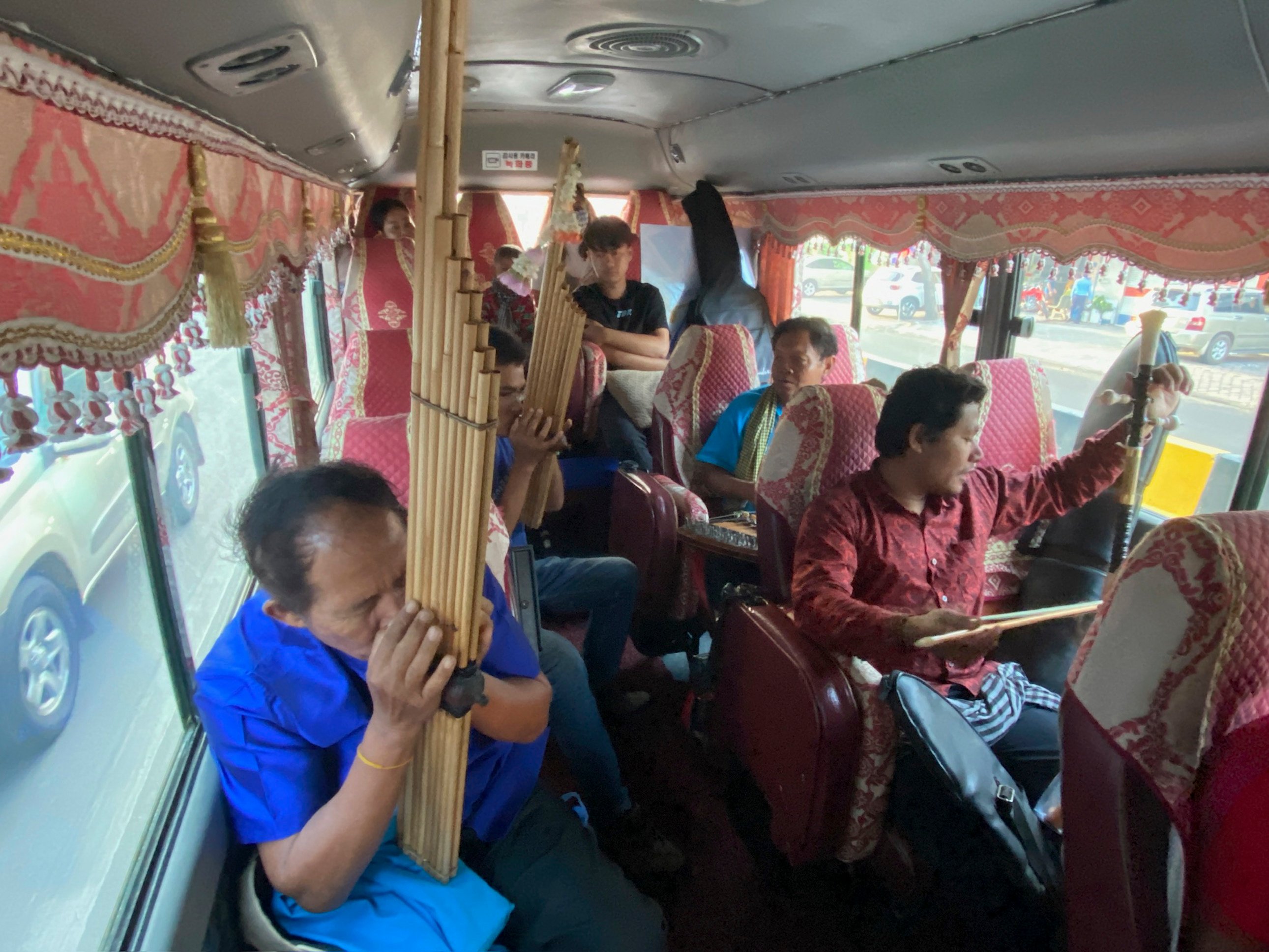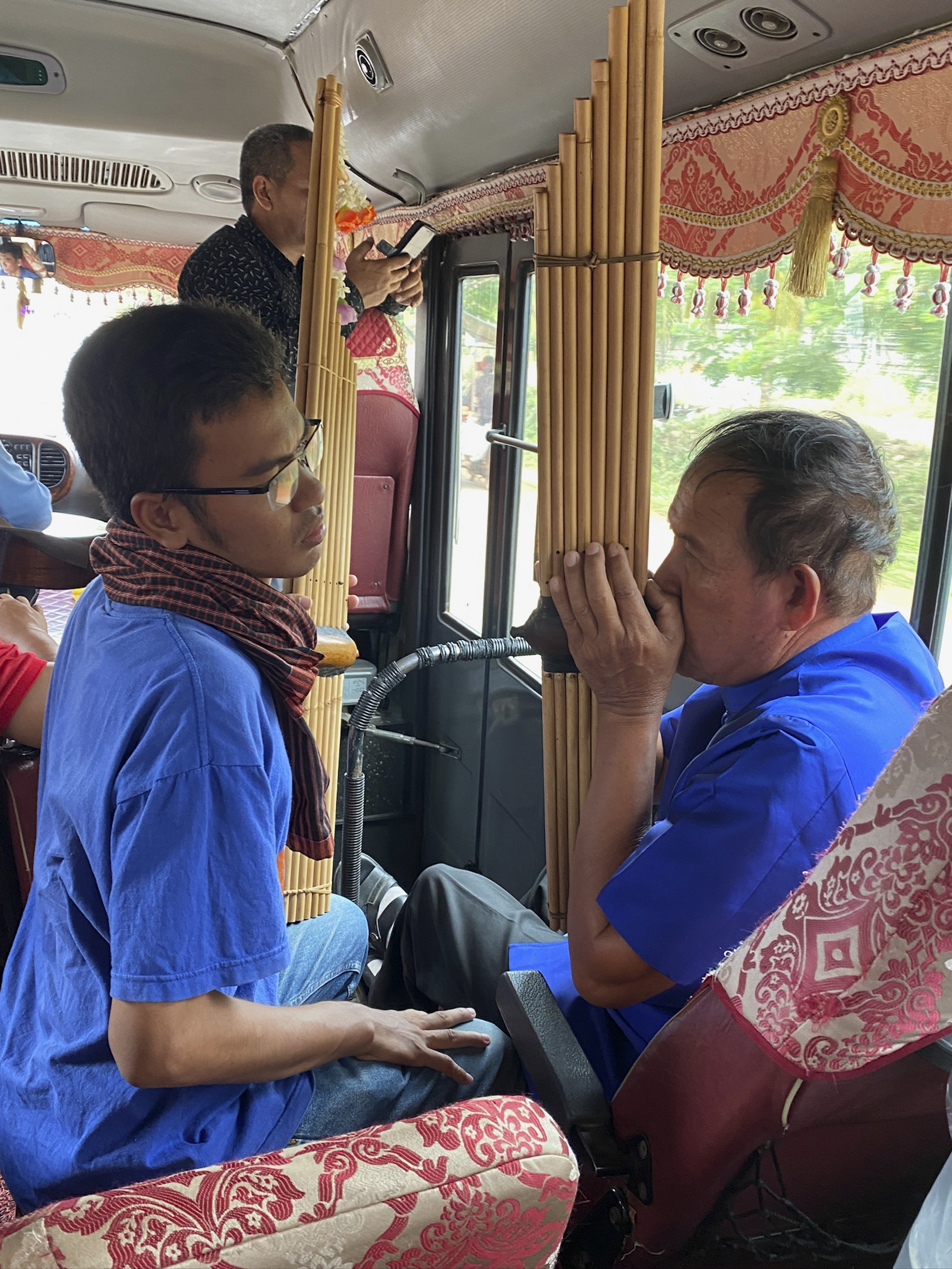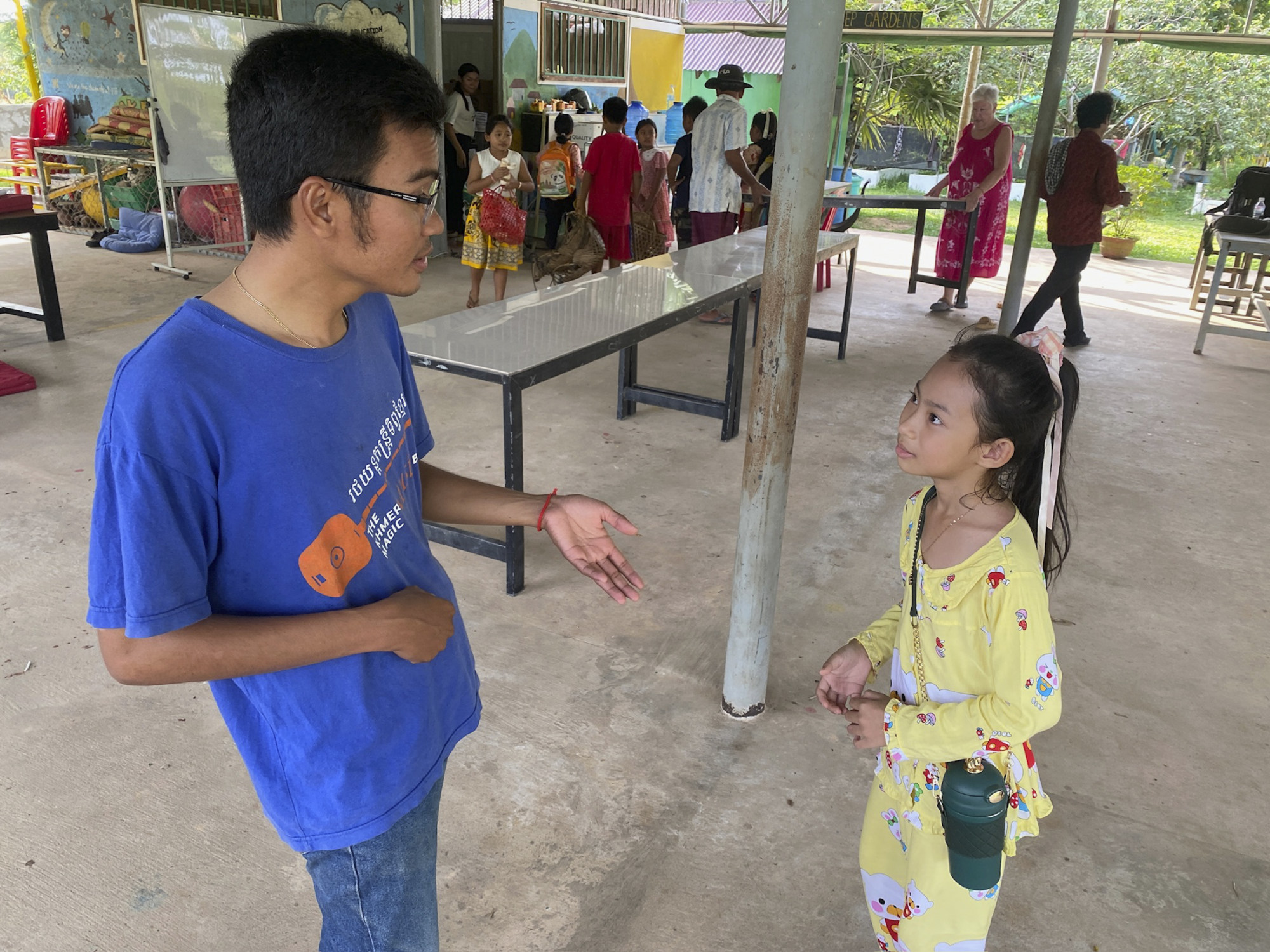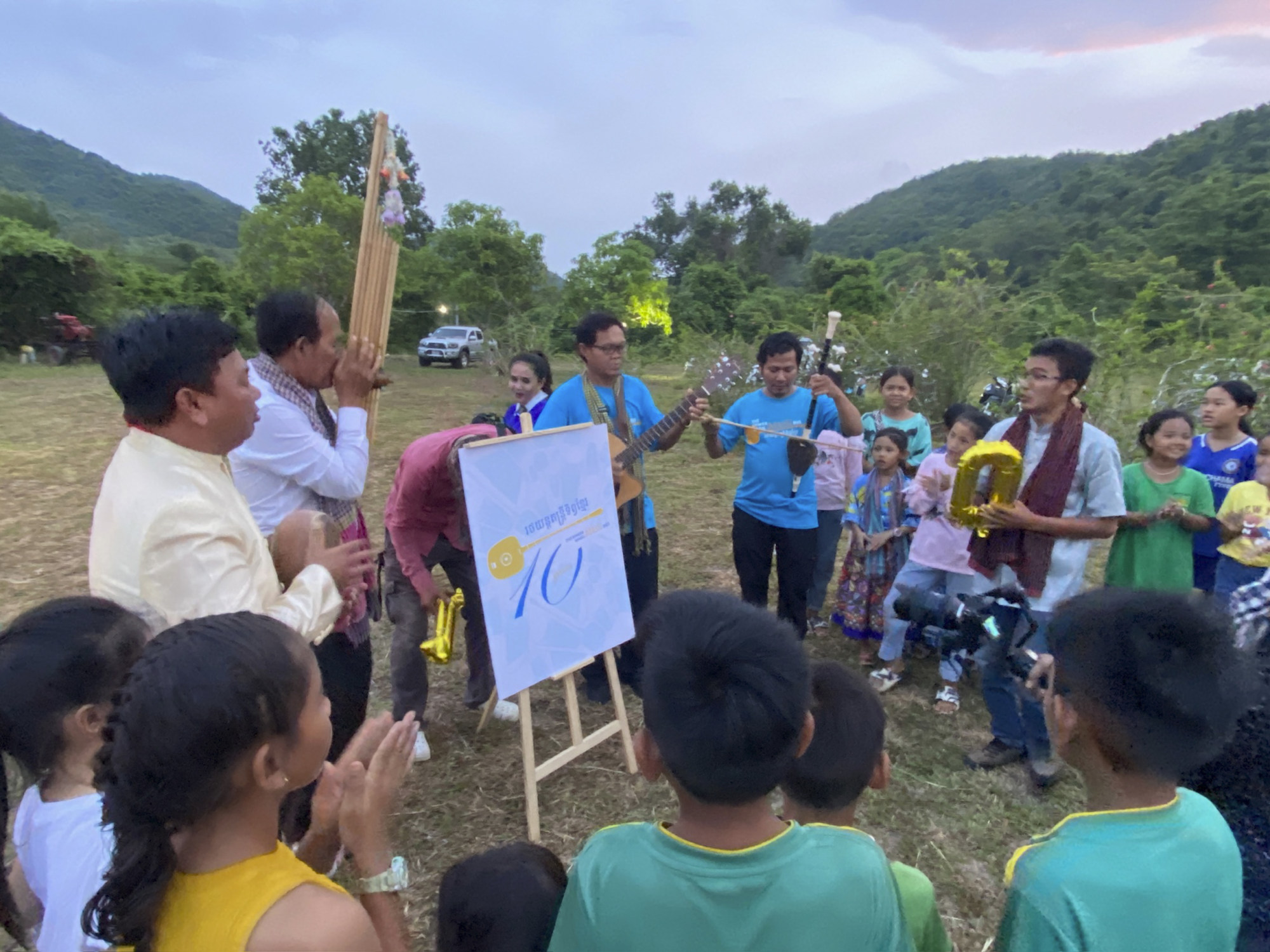- The Khmer Magic Music Bus takes traditional Cambodian instruments and songs across the country, hoping to reconnect locals with their national identity


Published: 11:15am, 17 Sep, 2023
On a bus rumbling along a road in southern Cambodia, past rice fields and stands of coconut palms, 30-year-old musical protégé Nou Samnang stares intently at the fingers of the master, Mon Hai, fluttering over the tiny holes in the upright bamboo pipes.
Nou Samnang is seated inches from the dignified, dexterous 67-year-old Mon Hai, trying to match the sounds to the finger placements just above the wooden mouthpiece, producing sounds somewhere between a harmonica and an accordion.
Songs played on the ancient instrument – a mouth organ called a khen – have been handed down, not by sheet music, but by the senses, and the ever-changing succession of notes is confusing to Nou Samnang as he tries to memorise the pattern while tapping his thigh to the melody.
The lesson is taking place on the Khmer Magic Music Bus, a troubadour transport created 10 years ago to bring traditional Cambodian instruments and music to villages and schools throughout the country.

This trip, the sixth after the project was sidelined by Covid-19 from early 2020 until late 2022, will travel from the capital, Phnom Penh, five hours into the countryside to a school that teaches English and vocational trades to village youth for free.
The 20-seat Hyundai bus is filled with six musicians, two singers and several relatives, and all their traditional instruments, including the kim, a dulcimer played with bamboo sticks, and the chapei, a long-necked, two-string lute.
Sitting in the front seat is the maestro behind it all, Arn Chorn-Pond.

His journey from genocide survivor to human rights activist led him and his supporters to found Cambodian Living Arts (CLA), 25 years ago, initially to revive the country’s traditional music, which was nearly wiped out by the Khmer Rouge, and later to support emerging artists.
Arn Chorn-Pond and his friends came up with the idea for the bus as a way to give masters such as Mon Hai a new stage on which to perform, to reconnect village elders to the music of a more peaceful time and to introduce children to instruments that most of them would not have heard of.
Historians and researchers calculate that at least 1.7 million Cambodians died from executions, torture, forced labour and starvation under Khmer Rouge rule from 1975 to 1979.
Many of the country’s musicians, artists and instrument makers perished under the regime’s warped ideology of erasing imperialist and Buddhist culture, and their artistic expressions, and replacing them with a collective, totalitarian state.

Mon Hai survived the nightmare toiling in rice paddies, so emaciated that he remembers feeling as if his protruding knees were bigger than his head. His mother died of starvation and, when the horror ended, he returned to his village near the Thai border to farm rice and cassava.
He was determined to learn the khen in honour of his father and grandfather, both of whom played the instrument and died before the genocide.
Mon Hai found the one remaining khen musician in the province to teach him and, years later, around 2008, CLA discovered and recruited him for its mission.
He was a founding member of the music bus in 2013, and he remains the only known master of the khen in Cambodia. One day, young Nou Samnang intends to become a khen master himself.

Coming from a poor family, Nou Samnang dropped out of school in the ninth grade to work as a housekeeper and security guard at a residence in Phnom Penh.
While he was taking an English class at a non-governmental organisation, CLA members came to talk to the students about the chapei, Cambodia’s signature traditional instrument.
As in other cultural traditions, the chapei player is like a minstrel, interspersing strumming with humorous, improvised commentary about the events of the day.
Nou Samnang signed up for free chapei lessons, and he proved to be a natural, not just at playing but in coming up with off-the-cuff riffs.
CLA leaders were so impressed with his playing and ability to sing in his beginner’s English that they awarded him a scholarship to study English for three years and sent him to a world music workshop in Singapore.
After he returned, Nou Samnang’s chapei mentor, Pich Sarath, invited him to play at CLA events. And when Arn Chorn-Pond and Thorn Seyma, the manager of the Khmer Magic Music Bus, heard him play in 2014, they asked him to join them on their next trip.
A few years later, he finished his high-school diploma on his own, at the age of 24, then during the pandemic, in 2020, he travelled to Mon Hai’s farm in remote Oddar Meanchey to study the khen.
In 2022 he earned a bachelor’s degree, and he is now studying for a master’s in political science while working for the government foreign affairs office as an escort for visiting dignitaries. He joins the magic music bus for its trips every couple of months or so.
As Nou Samnang peers at Mon Hai’s dancing fingers, the moment embodies the entire purpose of the bus and CLA: a young Cambodian inspired by traditional instruments and supported in taking them up, a master handing down his knowledge to a student, and both of them taking their culture back to the people.
He said, ‘Arn, I must die teaching my skill, not die as a drunk.’ This was a very dignified man who had lost all hopeArn Chorn-Pond talking about ‘kim’ master Yoeun Mek
Mon Hai is rehearsing the “Horm Rong”, the spirit song that alerts deceased masters that a performance is under way, honouring their achievements and conjuring them and myriad other spirits for backup.
“This is very important, it’s the starter song,” says Nou Samnang. “Before every concert we play this song first.”
Arn Chorn-Pond is about 60 years old – he is not sure if he was born in 1963 or 64 – and still trim with dark hair, high cheekbones and the clear eyes of a person who gets worked up about the injustices of the world but is satisfied with the way he has used his life to right them.
I ask him when he last travelled outside Cambodia as we eat a breakfast of pork and rice from styrofoam containers on the side of a busy highway an hour outside of Phnom Penh, at the start of our May trip.
“Five years ago,” he says. “I have no desire to travel. I did it early in my life and got sick of it, speaking and travelling all over the world.”

In 1988, Arn Chorn-Pond was on board a chartered jet with stars such as Bruce Springsteen, Peter Gabriel and Tracy Chapman. They were on the worldwide Human Rights Now! concert tour to mark the 40th anniversary of the Universal Declaration of Human Rights and the work of Amnesty International.
“We went to about four or five continents,” Arn Chorn-Pond says. “They had two speakers, I was one of them […] They didn’t know who I was among probably 100 people on the plane.
“They assigned seats. Bruce Springsteen was right in front of me with his girlfriend. They were always kissing. He said, ‘Who’s that boy sitting behind us?’ I was asked to speak at the press conference, and then they knew.”
What he shared was a condensed version of the story he started telling in the early 1980s about the barbarism of the Khmer Rouge and how he survived the genocide by learning to play the kim in a labour camp band around the age of 11. And how the propaganda songs they played were used to mask the sounds of the bludgeoning and screams at nearby pits.
Graphic novel retells the story of Khmer Rouge horrors21 Feb 2020
He also spoke of how, when Vietnam invaded Cambodia, in late 1978, to bring an end to the genocide and take over the country, he was forced to be a child soldier for the Khmer Rouge, before eventually escaping to a refugee camp in Thailand. And how he was adopted by American clergyman Peter Pond and educated in New England.
He spoke of how he suffered from nightmares, guilt and trauma in a strange new land, where his classmates were ignorant of his story and called him “monkey”, and how he finally found his voice and told crowds – including at meetings of Amnesty International, Unicef and Children of War – about his life and the atrocities.
But that was just the start of his journey. Several years after the Amnesty tour, Arn Chorn-Pond returned to his hometown, in Battambang, northwest Cambodia, and discovered the old master musician who had taught him to play the kim in the labour camp.
The master, Yoeun Mek, was cutting hair on the pavement and numbing the pain of the past with alcohol.
“He said, ‘Arn, I must die teaching my skill, not die as a drunk,’” recalls Arn Chorn-Pond. “This was a very dignified man who had lost all hope. And so many other well-known masters of different art forms lived in the streets in obscurity, and that put ideas in my head.”

In 1998, with help from supporters in America such as Alan Morgan, John Burt, Charley Todd, Judith Thompson and Jocelyn Glatzer, he founded CLA as a platform for master musicians to teach and perform the traditional music that was nearly annihilated by the Khmer Rouge.
“To heal properly you have to have self-esteem, and to have self-esteem […] you have to have identity, and that’s in their music, their culture,” Arn Chorn-Pond says on the bus, wearing his signature chequered krama scarf.
“That’s why the Khmer Rouge destroyed it, because identity makes you feel human.”
The idea for the bus was born in 2012 as Arn Chorn-Pond, Thorn Seyma and Mon Hai were guiding a group of American high-school students and their chaperons and teachers, Steve Riege and Karen Bovard, around the country on a service-learning trip.
The students were from Watkinson School, in Connecticut, and groups of them had been coming each summer for seven or eight years, after Arn Chorn-Pond had spoken at their school about the story behind CLA.
Some of them who survived the Khmer Rouge told us, ‘I’m very happy to hear the kind of music I heard when I met my husband, when I met my wife, 50 years ago. I never thought I would hear this music againArn Chorn-Pond
They were going to Mon Hai’s village, in Oddar Meanchey, and to meet up with musicians across the border in Thailand, Riege recalls.
The students often constructed buildings in villages and music was always a part of the trips. At one pit stop, under a big tree in the middle of a field, Mon Hai started to play the khen.
“He’s a mesmerising character, swaying, playing in the middle of the jungle on this little dirt road,” Riege tells me on a recent video call. “All of a sudden there were some little kids that came out from behind trees and they were transfixed, and then some adults came out and people were just kind of slack-jawed watching this.
“I’d never seen a response to music like that.”
Thorn Seyma remembers a woman in her 80s who had lost her family to the genocide. She came to hear Mon Hai play, telling her, “‘Please, do this more and more for other villages, other people. You need to remind them.’”
After that experience, they all came to the same conclusion, as Riege recalls: “All we have to do is get a bus, because all these masters want to do is play music, and we’ll support them and take them to the countryside to play music, and people will be happy and their lives will change.”

Riege and a colleague, Tom Gromak, devised a crowdfunding campaign and in 30 days they raised US$36,000. Within weeks Thorn Seyma had bought a used bus with 28,000km (16,000 miles) on the clock, 15 seats in the back and three flip-down seats in the aisle.
They went on the road three times that first year. According to the newsletters Riege sent out to bus supporters, the trips included one north of Battambang, where Arn Chorn-Pond and Yoeun Mek performed in a concert attended by former Khmer Rouge officers.
“Imagine the power of music in bringing all these people together to enjoy the traditional sounds of their own culture,” Riege wrote to supporters.
As the bus nears our destination, Arn Chorn-Pond ruminates on the many times that elders and children have been moved by the music.
“Some of them who survived the Khmer Rouge told us, ‘I’m very happy to hear the kind of music I heard when I met my husband, when I met my wife, 50 years ago. I never thought I would hear this music again […]
“The young people, the children, they had never heard or seen any of these instruments on their own – their heritage.”
How this looted Cambodian statue revealed a vast smuggling network19 Jun 2023
We pull up at the Kep Gardens Association, the grounds surrounded by lush, forested hills, the one-storey buildings filled with children learning English. Australians Janine and Andrew Judd founded the non-profit school in 2008, having seen a need for English education in an area popular with tourists and with a hole in their own lives to fill.
Janine tells me that their only son had died in a car accident in 2004. And, two years later, they travelled to Cambodia, to visit the family of one of Andrew’s colleagues in Kep.
The despair over her son was so debilitating that Janine felt she had nothing to look forward to. Then she met a Cambodian woman who had lost her entire family in the genocide, but was persevering, working in the village, sharing meals with friends, laughing.
“They were good for me, they broke me out of that stupor,” she says. “It sort of brought me back to life. They don’t know that, but I owe them a big debt.”

Now the school has 410 students of all ages on campus daily, before and after their state-school lessons. This year, Janine messaged Thorn Seyma to see if the magic music bus, which had visited in 2015, was still around after Covid-19.
They decided to hold a joint celebration for the 15th anniversary of Kep Gardens and the 10th year of the bus.
Under the open-air pavilion, the musicians unpack their instruments and nearly 100 children aged six to 12 stream in and sit on the rattan mats.
They stare wide-eyed as the musicians describe and play each instrument: the bamboo-piped khen, used to summon spirits; the storyteller’s chapei lute; the ox horn, used to call elephants in the jungle; the dulcimer-like kim; the takhe, a sitar-like floor zither; and the tro Khmer, an upright three-stringed fiddle, all of which are common at marriage ceremonies and had perhaps been part of their parents’ weddings.
From the show of hands, it is evident that hardly any of the children have heard of these instruments before.
The sounds float separately, then together, in the warm air, mixing with the rustling fronds and the thud of a soccer ball kicked on the field outside. The music has harmony and at the same time sounds dissonant.

Traditional Cambodian music is related to the music of Thailand and Laos, and functions like a lot of other Asian music styles in that it’s heterophonic, explains Elise Steenburgh, an American ethnomusicologist who has ridden on the bus two dozen times and speaks with me on the same video call as Riege.
“What Cambodian music does is everybody is playing the same melody, but each instrument elaborates that melody in its idiomatic ways, the ways that make sense to that instrument,” she says. “So for a bowed string instrument, adding trills as you play, that makes a lot of sense for that instrument.”
Steenburgh is working on her doctoral dissertation on how NGOs in the arts in Cambodia, including CLA, function in a post-conflict society.
“These types of organisations have become very important to the survival of traditional music, I would say globally,” she says. “And the great thing that CLA is doing is it’s using its resources to give a platform to Cambodians to make the music and the art that they think is best.
“They’re pushing the envelope and there’s a lot of traditional and modern stuff happening – that is, music and the performing arts more generally – that is really vital.
“There’s a lot of vitality in Cambodia, from what I’ve seen, people doing new stuff, carrying the past into the future.”
How dams in China are destroying livelihoods downstream in Cambodia12 Jun 2023
In the pavilion, when Nou Samnang takes the floor, he has the children laughing and shrieking as he calls on volunteers to enact a scene in a traditional opera.
They giggle and erupt into applause as he strums and sings about the music bus, the school and their English lessons, delighting them as he mispronounces words like dog and apple.
Afterwards, a student, nine-year-old Chun Puth Rangsey, says the chapei is her favourite, because “it makes me happy”. She says she’d like to learn to play it.
“I am in Phnom Penh, if you want to come and learn,” Nou Samnang tells her. “I teach for free. So no money, just come and learn the chapei.
“Keep learning more from your teacher,” he says. “Try your best, speak in English, and don’t forget your Khmer literature.”
“Yes,” she says.
‘I feel healed’: dad opens up on horrors of Khmer Rouge in US podcast24 Jul 2022
That night several hundred locals turn out for the celebration. On a stage in a field, after the bus troupe shoots a 10-year promotional video, Mon Hai plays the spirit song to start the night’s concert and Thorn Seyma, her brother Dika and Nou Samnang sing.
Arn Chorn-Pond stays out of the spotlight, content to let the others shine while he shoots videos.
A light rain and a long drive back to Phnom Penh hasten our departure after Nou Samnang and Thorn Seyma sing a famous lullaby.
“We are healing one village at a time, one kid at a time,” Arn Chorn-Pond says as we ride through the night. “It’s magical to have kids just hear the instruments. They connect to it deeply.
“The young people of Cambodia will not move away from the ‘killing fields’ if we are not healing ourselves properly. And I think music – getting people together, the Khmer Magic Music Bus, the work of Cambodian Living Arts – is healing me […] And I’m using it on a bigger scale to heal my people and Cambodia.”

+ FOLLOW
Patrick Scott is a travel writer based in Chiang Mai and Denver.